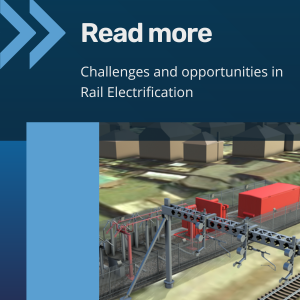Published last year, the All-Island Strategic Rail Review (AISRR) offers a joint strategy to enhance and expand the rail network across the entire island of Ireland. The plans set out by the governments of both countries include recommendations to electrify and decarbonise the rail network across Northern Ireland (NI) and the Republic of Ireland (ROI) by 2050.
Currently Ireland has the lowest level of electrified railway in the European Union; NI has no electric railways at all. Under the plan proposed by the AISRR, 80% of trains would be electric, with the rest powered by battery or hydrogen. Achieving this will require a substantial programme of electrification and rail infrastructure upgrades over the next decade.
The electrification of railways is a complex endeavour, requiring experienced civil engineering and civil design expertise. Our talented team at Whitfield Consulting Services (WCS) is well-versed in the challenges of rail electrification from our experience working on projects in Great Britain, where the government’s ambition of running an entirely net-zero rail network by 2050 is firmly underway.
And, with a team at our offices in County Armagh, we are armed with the local knowledge needed to apply these learnings to AISRR projects on the island of Ireland.
Experienced civil engineering expertise for complex rail challenges
WCS’s railway electrification experience includes providing survey and civil engineering design to various stages of the Midland Main Line upgrade and the provision of detailed design and checking services for the Great Western Electrification Programme – both billion-pound government schemes – plus detailed civil engineering design and other services as part of the electrification upgrade to London’s Piccadilly Line.
“We have built up considerable experience in rail electrification, including work that has required complex civil engineering solutions,” says Asa Whitfield, Managing Director at WCS. “So, we understand the unique challenges of rail electrification projects – and the problems clients often come up against – and we can offer guidance based on a wealth of on-site experience.”
WCS’s experience also extends to the Intercity Express Programme Doncaster Depot Power Upgrade, where the team provided civils design of two substation compounds to house a Static Frequency Converter as well as a 33kV substation and 25kV Feeder Station. WCS also designed approximately 3.5km of cable feeder route to overhead line electrification (OLE) connection points, plus provided ongoing CRE appointments for Construction and Design during the implementation phase.
An opportunity to transform Ireland’s railways
“Our rail network has been neglected for quite some time, so the AISRR presents a fantastic opportunity to transform the state of public and freight transport on the island of Ireland,” says Dave Crumley, CAD/BIM Manager at WCS, who works from our office in County Armagh.
If the recommendations of the review were delivered, 700,000 more people would live within 5km of a railway station; railway journey times between the island’s major cities would be reduced significantly, by 50% in some cases; and there would be a €20bn / £17bn boost to the island’s economy, according to the Department of Transport and the Department for Infrastructure.
“At WCS, our focus is on providing civil engineering expertise for projects that are contributing to the global movement towards net zero emissions,” says Dave “The goals of the AISRR – with its ambitious decarbonisation targets – align perfectly with our core values and areas of experience.”
Click here to read more about the challenges and opportunities in rail electrification.
Expert support to help deliver AISRR ambitions
“The NI and ROI governments will need to overcome many challenges to achieve their ambitions. This includes securing private and public funding, as well as gaining support from the public for the projects,” says Dave.
“With our experience in rail projects, I can foresee areas of challenge where civil engineers and technicians can offer valuable expertise and guidance.”
Achieving the goals of the AISRR will likely involve significant infrastructure projects that could necessitate acquiring land for new rail lines, stations, and other related facilities such as viaducts. “WCS’ engineers can offer guidance on route proposals and implications, finding the best solutions for our clients,” says Dave.
Through creative problem-solving born out of experience, engineers, working in collaboration, can help to keep land acquisition to a minimum.
For example, on the Midland Main Line upgrade project, Network Rail had initially planned to purchase land to install road rail access points (RRAP) at the Sharnbrook site. However, SPL Powerlines proposed relocating the OLE equipment within the existing site to avoid land acquisition. Our team provided the civil engineering design to realise this concept and to evidence that it would work in practice, with the support of our regular partners and OLE specialists, Andromeda Engineering.
Specialist knowledge to overcome infrastructure challenges
Electrifying the Irish railway will require substantial investment in power and energy infrastructure to connect both the 650km of new lines planned and upgraded existing 2,300km of public rail network to the island’s electricity grid.
“Projects traversing countries with different systems and types of infrastructure in place can also present unique challenges,” adds Dave. “For example, some railways will operate on an alternating current (AC) system whereas others use a direct current (DC) system.”
Specialist support, from experienced engineers who understand the standards required for both rail and electrical projects and are able to apply them confidently, is required. WCS’s specialist support for rail electrification includes substation civil design and cable routing.
“There are several design options for substations; guidance from an engineer is needed to determine which type is most suitable for a project, and a lot of it will come down to site requirements and previous experience is key to offer clients informed solutions,” comments Dave.
WCS has extensive experience in this area. See our Midland Main Line case study for insights into how we provided civil design to enable the transportation of the UK’s largest ASG25 substation to site, plus how we provided civil engineering support for three substations on the line.
A trusted and reassuring voice
“As trusted experts, we are often called on to provide assurance on design plans,” adds Dave.
WCS has provided design assurance for a number of projects in the rail sector, including design assurance for the permanent works at Padiham National Grid substation in Burnley, for our client Hitachi Energy. The project involved the construction of a new 132kV Gas Insulated Switchgear (GIS) building to replace the aging infrastructure.
Our design assurance expertise extends beyond rail, with Hitachi Energy also choosing WCS to provide civils design reassurance for its project to extend the existing Eccles 400kV substation in Scotland with new buildings to house two new synchronous compensators. This ongoing role includes checking documents and drawings to ensure they are in accordance with UK and relevant client and National Grid standards.
Specialist support where you need it
The need for our expertise can extend beyond early project stages, with WCS often asked to provide a Lead Civil Engineer to be embedded onsite to oversee all works. This was the case with the Piccadilly Line upgrade project; our Director, Nick Lowe, was named as Lead Civil Engineer, with responsibilities including liaising with lead engineering staff from UK Power Networks Services and London Underground throughout the project.
Our team are also often nominated as the Temporary Works Co-ordinators on projects; temporary works is another key area of expertise for us. Neglecting consideration of temporary works during permanent design can lead to serious problems, including delays, cost over-runs, and contractual disputes.
Click here to read our article on how full and early collaboration between permanent and temporary works designers is vital to constructability and the control of cost and risk.
Collaborative, specialist SMEs to provide in-depth knowledge
“Being an SME allows us to be agile, which our clients really value,” says Dave.
WCS has a long-standing partnership with Andromeda Engineering, a fellow SME specialising in multidisciplinary design and engineering for rail systems.
With our experience with rail civils design, complemented by Andromeda’s expertise in OLE, signalling, HV and LV systems, our partnership is highly effective for rail electrification schemes.
Click here to read more about the partnership and the benefits of working with SMEs on rail projects.
WCS’ presence and expansion in Ireland
As well as a London office, WCS has a team based in Armagh offering our services for clients’ power and energy, rail and infrastructure projects.
“With so much investment happening in the infrastructure across the island of Ireland – in both power & energy and rail – it is fantastic that WCS has a presence here and concrete plans for growth,” says Dave.
Click here to read more about WCS’ Armagh office.
Trust built on experience
Civil engineering expertise will be vital in electrifying and decarbonising Ireland’s railways. The AISRR outlines ambitious plans to electrify 80% of the trains in NI and ROI; this complex undertaking demands the knowledge of specialised and experienced civil engineers.
WCS brings a wealth of experience in rail electrification from current and previous projects, complemented by local expertise from team members in County Armagh. Our proven track record in delivering civil engineering solutions for significant infrastructure projects positions us well to support Ireland’s transition to a modern, electrified, and more sustainable rail network.
In addition to rail electrification, WCS is also experienced in rail power, civils and structures projects. Visit our portfolio for more insight, or contact us via our contact page.

